By Joseph R. Svinth, with Curtis Narimatsu, Paul Lou, and Charles
Johnston
Copyright © EJMAS 2003. All rights reserved.
On January 17, 1893, American settlers led by Sanford B. Dole overthrew the Hawaiian monarchy. Dole and his friends then offered the Hawaiian Islands to the United States. The US Congress wanted to accept Dole’s offer, but President, Grover Cleveland was an isolationist who disliked filibustering, as causing insurrection for purposes of advancing American economic interests was then known. Consequently, the US government rejected Dole’s offer. Nonplused, on July 4, 1894, Dole and his friends established the Republic of Hawaii, with Dole as its president.
Three years later, William McKinley became President of the United States. McKinley. McKinley was an expansionist, as imperialism was then known, and so, in June 1898, the US government voted to annex Hawaii. The US Navy landed troops at Honolulu in August 1898, and Hawaiian sovereignty transferred to the United States.
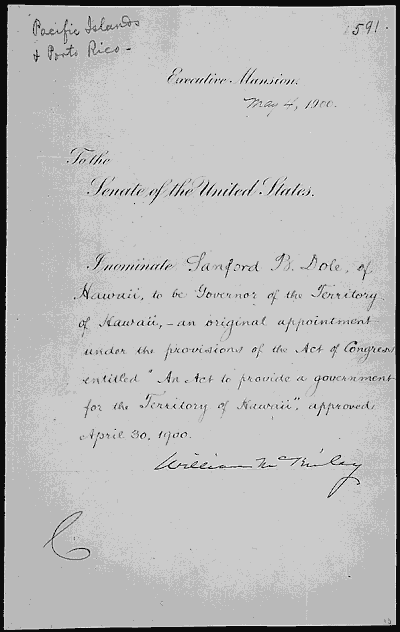
Message from William McKinley nominating Sanford B. Dole as governor
of Hawaii. Note the letterhead, "Executive Mansion," rather than "White
House." Courtesy the Center for Legislative Archives, National Archives
and Record Administration, Anson McCook Collection of Presidential Signatures,
NWL-46-MCCOOK-3(11).
From August 1898 until December 1941, the Territory of Hawaii was under joint military and civilian administration. However, following the Japanese attack on Pearl Harbor in December 1941, the US Army put the Territory of Hawaii under martial law. Because the Army’s leadership did not trust people of Japanese ancestry, martial law did not end until October 24, 1944. To reduce the risk of undergoing extended martial law in future, Hawaii’s civilian leaders, many of whom were of Japanese ancestry, began pushing hard for statehood, which was achieved on August 20, 1959.
Because of the confluence of social and political factors, the history of Western boxing in Hawaii has three separate eras.
Military Boxing
In 1893, the US Navy began stationing warships at Honolulu, where their sailors and Marines were used to prop up the Dole administration. There were boxers aboard these warships. For example, during the winter of 1893-1894, the future heavyweight champion Tom Sharkey, then serving aboard USS Philadelphia, fought at least 14 bouts in Honolulu.
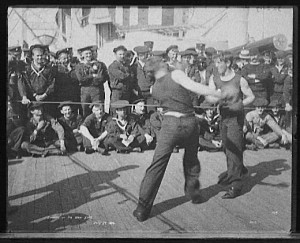
Boxing aboard USS New York, July 3, 1899. Photographer: Edward
H. Hart. Courtesy the Library of Congress, Prints & Photographs Division,
Detroit Publishing Company Collection, LC-D4-32317.
The First New York Volunteer Infantry established the first Army camps in Honolulu during the summer of 1898, and the Regular Army established its first permanent post, Fort Shafter, in 1907. In January 1913, the War Department transferred a black regiment, the 25th Infantry, to Fort Shafter. Some of these soldiers were boxers. Thus, the Honolulu Advertiser wrote, "The Twenty-fifth is proud of its colored ringmasters and particularly of Hollie Giles, a welterweight of 155 pounds, who is described by the men as a ‘whirlwind’ fighter; Morgan, a heavyweight at 190 pounds; Carson, a light heavyweight, and Ananias Harris, a light heavyweight."
In those days, military boxing was subject to Sections 320 and 321 of the US Code. These statutes stated that exchanging blows for money or a thing of any value, or for a championship, or for which admission was charged, or for which money was wagered, was illegal. In 1915, the Army circumvented these laws by ruling that soldiers could box in garrison if there were no admission charges, no challenges from the ring, no decisions announced at the end of fights, and no obvious gambling. The first smoker following this decision took place at Schofield Barracks on October 9, 1915, and subsequently, boxing exhibitions were common on holidays such as Thanksgiving, New Year’s, and the Fourth of July.
Early boxing promoters at Schofield Barracks included Major Edmund Butts, whose publications included books and magazine articles touting the benefits of boxing as a pastime for soldiers, and the regimental chaplain. During the early 1920s, local promoters included Tommy Marlowe and Lieutenant Barnard of the 5th US Cavalry, and Sergeant John Stone of the Ordnance Department. At Fort_Derussy, promoters included Sergeant Anthony Biddle of the 17th US Cavalry. Boxers assigned to Army units in Hawaii during the late 1910s included the 25th Infantry’s Henry Polk ("Rufus Williams") and Private Settles ("the Kentucky Chap"), and the Signal Corps’ Joseph Podimik ("Joe Potts").
According to the Advertiser (November 27, 1915), the Schofield ring was "set up on the cavalry parade and an abundance of chairs at the ringside, an amphitheatre of bleachers, and seats on the adjoining troop quarters [gave] better accommodations than [did] the seating arrangement of any hall on post." Unfortunately, the Schofield bleachers provided no protection from the afternoon rains, and without electric lights to illuminate the twilight, the audience had a hard time seeing the last rounds of the main event.
During the 1910s, Pearl Harbor became a major US naval base, and in 1921, Sub Base Pearl Harbor’s Sharkey Theater became the first covered boxing arena in Hawaii. [EN1] From 1918-1924, civilians often attended Pearl Harbor bouts. However, this ended in 1924, when Rear Admiral John McDonald decided to close Pearl Harbor boxing matches to civilians and soldiers. The reason was that McDonald felt that it was ungentlemanly for the audience to boo and make disparaging remarks about the contestants and referees.
Once Pearl Harbor closed to civilians, the Hawaii National Guard began patronizing boxing. Guard boxing coaches included Jim Hoao and Bill Huihui, both of whom had boxed professionally in Hawaii during the early 1900s. Boxers trained by these men included Patsy Fukuda, Hiram Naipo, and Gus Sproat. The Honolulu Armory was the usual venue for these fights.

Patsy Fukuda, circa 1930. Courtesy Patrick Fukuda.
Hawaii’s most acclaimed military boxer of the bootleg era was probably
Sergeant Peniel R. "Sammy"
Baker. Baker began his amateur career at Schofield Barracks in 1922.
At the time, he was 20 years old, and serving in the 21st Infantry. Baker
was the Hawaiian military welterweight champion in 1923 and 1924, and a
runner-up in the selection for the US Olympic team in May 1924. Following
the Olympic tryouts, Baker transferred to Mitchel
Field, on Long Island. Baker obtained his discharge in September 1924,
and by 1928, he was ranked the fifth best welterweight in the world.
Civilian Boxing
Bill Huihui was among the earliest Hawaiian-born boxers. Born at Pauoa, Oahu, in 1875, Huihui went to sea as a young man, and learned to box in San Francisco. In 1902, he started boxing for Honolulu’s Kapiolani Athletic Club, and his first Hawaiian professional bout took place soon afterwards, at the Orpheum Theater. This was a 4-round semi-main event, and the opponent was Jack Latham. Subsequent opponents included Nelson Tavares, Jack Weedy, Dick Sullivan, Kid De Lyle, and Tim Murphy. Huihui retired from the ring around 1909, but continued coaching boxers until at least 1924. Because he worked as a policeman, Huihui’s local trainers may have included the Honolulu Police Department boxing instructor, R.A. Wood, a Scot who settled in Honolulu in the early 1900s.
Bill Huihui. From the Advertiser, September 10, 1904
Another early Hawaii-born boxer was Nelson Tavares, "the Punchbowl Demon." Tavares claimed the Territorial lightweight championship from 1905 until 1908, and his opponents included the middleweights Cyclone Kelly, Dick Sullivan, Tim Murphy, and Mike Patton, and the lightweights Charlie Riley, Frankie Smith, Frank Rafferty, and Joe Leahy. After retiring from the ring, Tavares became a garage owner on Bishop Street.

Nelson Tavares. From the Advertiser, June 17, 1908
During the 1910s, a few Hawaii-born boxers began establishing reputations
on the Mainland. For example, in October 1912, the Advertiser mentioned
that Manuel "Battling" Viera of Hilo was boxing in San Francisco. Viera
was still fighting in San Francisco in 1919, when he fought a four-round
draw with Joe "Young" Azevedo. Originally from Honolulu. Azevedo began
boxing in Oakland around January 1913, at which time he was aged 17. Azevedo’s
wins included at least two victories over Tommy McFarland and another over
former lightweight champion Ad Wolgast. After a ring injury caused him
to go blind in one eye, Azevedo settled in Sacramento, where he died of
a heart attack on February 19, 1934.
Vaudeville Exhibitions
Until the 1910s, many Honolulu boxing matches took place inside vaudeville theaters. To circumvent laws prohibiting prizefighting, these matches were called exhibitions. For example, on May 28, 1904, Paddy Ryan organized a boxing card at the New Chinese Theater on Hotel Street. The main event featured Frank Nichols of Honolulu versus USS New York’s Sailor Robinson. Likewise, on June 22, 1911, the Honolulu Eagles hosted a show at the Bijou Theater that featured "fun in boxing land." The main event featured Mike Patton, who claimed to be the champion of the Far East. Finally, on June 11, 1913, Jim Hoao lost a 15-round decision to Private Morris Kilsner during a bout held at Honolulu’s Ye Liberty Theater. [EN2]
Famous champions sometimes took part in these exhibitions. For example, during July 1894, John L. Sullivan was on a trip to Australia, and while in Honolulu, he gave an exhibition at the Opera House. His opponent was a sparring partner named Fitzsimmons (not Bob). Similarly, during November 1907, the visiting lightweight champion Jimmy Britt gave a demonstration to the "sport-loving people of Honolulu." The Advertiser noted that the latter exhibition was "of such character that women can safely attend." (In those days, society discouraged women from attending fights, but some went anyway, usually watching from backstage.)
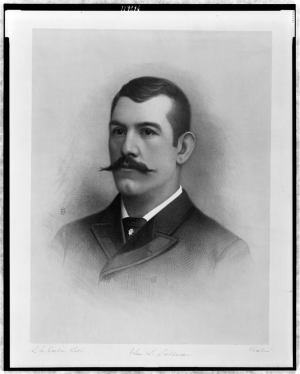
John L. Sullivan. Lithograph by Scott C. Carbee, sometime between
1880 and 1910. Courtesy Library of Congress Prints and Photographs Division,
LC-USZ62-119896.
Another way that vaudeville managers circumvented the law was by advertising the boxing as part of a novelty act. For example, in December 1915, the Welsh welterweight Fred Dyer, who advertised himself as "the singing boxer," appeared at the Popular Theater in Honolulu. Dyer was en route to California from Australia, where his opponents included Fritz Holland and Les Darcy.
The vaudeville promoters generally arranged these fights without asking
the consent of either boxer. Instead, they simply told the men that they
had a fight lined up. Then the boxers either showed up or they didn’t.
Boxing during Public Holidays
During the early 1910s, boxing was sometimes part of the festivities associated with public holidays such as Fleet Week, New Year’s, and the Fourth of July. For instance, on July 9, 1910, Jim Hoao fought a military boxer at Aloha Park in Honolulu.

Honolulu in 1910. Photographer: Robert K. Bonine. Courtesy the Library
of Congress, Panoramic Photographs Collection, LC-USZ62-125408.
However, because of opposition from the US District Attorney, Jefferson McCarn, there was no off-post boxing in Hawaii between July 4, 1913 (Young Johnson versus Kaina Opo at Wailuku) and December 31, 1918.
The bout that got things started again was part of the New Year’s celebration at the Iolani Palace, and it featured a Chinese ("Happy-Go-Lucky", originally from Macao) against a Filipino (Raphael Carpenterio, "the Manila Demon"). Although no admission was charged, the Advertiser still called it "the first real stage affair of its kind held in Honolulu since ‘Old Rose’ Jeff McCarn assassinated the sport in Hawaii." On August 21, 1919, there were also boxing matches between soldiers and sailors at Moili’ili Park. Non-military participants included Carpenterio, Young Johnson, Akana, and En You Kau.
YMCA patronage was probably involved in this post-World War renaissance, as on March 4, 1919, the Central YMCA of Honolulu organized a "stunt night" that featured boxing, wrestling, sumo, and judo. The boxers included Jimmie Flynn versus Jimmie White, Price versus Wilkinson; and the Wright brothers against each other. All the boxers on this card were welterweights except Wilkinson, who was a middleweight. Similarly, in September 1928, the Oahu County YMCA organized a camp at which boys boxed. The athletic director at the Y, Charles Pease, was a former soldier who based his program on World War-era military training.
Additionally, veterans and fraternal groups sometimes organized smokers
as fund-raisers. For example, on May 13, 1922, the Veterans of Foreign
Wars hosted a bout featuring Dynamite Tommy Short and Kid Oba (Jack Osoi).
Short tried for the knockout, but ended up with a draw. Similarly, on August
29, 1925, the American Legion staged a smoker at the Hilo Armory.
Fight Clubs
During the 1920s, boxing left the vaudeville houses and public parks for fight clubs.
On Big Island, the Women’s Christian Temperance Union was strongly opposed to boxing. Consequently, efforts to promote boxing in Hilo led to legal action. To the disgust of the temperance leaguers, the court actions eventually led to the legalization of boxing in the Territory, but meanwhile, there was little organized boxing on the Big Island.
However, on Oahu, the Honolulu business community generally supported organized boxing. For example, fans attending the fight between Battling Bolo (Elias Cantere) and Alky Dawson at the Honolulu Armory on March 18, 1927 included the territorial governor (Star-Bulletin publisher Wallace Farrington) and the Honolulu mayor (Charles Arnold). According to the Advertiser (April 15, 1928), their official stance was that these bouts were legal as long as admission was not charged at the gate and the fighters received payment in private.
The Hawaiian fight clubs of the 1920s were usually warehouses with a ring in one corner. To avoid legal problems, police got in free and boxing fans bought daily memberships rather than tickets. Prices for daily memberships ranged from 50¢ in the gallery to $2.00 in stage seating, and these memberships had to be purchased in advance.
Ethnicity played an important role in these fight clubs. For example, many Filipinos were inspired to become boxers by the victories of Pancho Villa, the first Filipino to become a world boxing champion. Meanwhile, K. Oki, a Honolulu businessman of Japanese descent, was inspired to provide financial support to Honolulu boxing clubs after seeing Japanese college students boxing at Tokyo’s Hibiya Park during 1926.
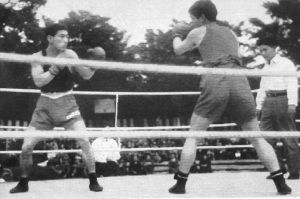
A bout between boxers from Chuo University (left) and Hosei University
in Tokyo. Many Japanese collegiate boxers of the mid-1930s were ethnically
Korean.
From Arthur Grix, Japans Sport in Bild und Wort (Berlin: Wilhelm
Limpert-Verlag, 1937).
For Filipinos living on Oahu, Honolulu’s Rizal Athletic Club was an important fight club. Rizal held its first smoker on July 8, 1922, and in the main event, Kid Parco defeated Alky Dawson in six. The preliminaries were supposed to feature Jackie Wright versus Cabayon, Hayward Wright versus Pedro Suerta, Tommy Dawson versus Moniz, and Tommy Short versus Kid Oba. Unfortunately, Kid Oba was a no-show, as he died of lockjaw on June 28, 1922. He was aged 17. Other boxers associated with Rizal Athletic Club smokers include Patsy Fernandez, Battling Bolo, Young Malicio, Clever Feder, Pedro Suerta, Moniz Santiago, and Cabayon.
For Portuguese, an important club was the Kewalo Athletic Club, managed by A.K. Vierra. Portuguese boxing idols included Don "Lefty" Freitas and Jack Silva.
For Chinese, it was the Chinese American Athletic Association, managed by Chang Kau. Chang’s brother Dick boxed professionally in California, and later became a well-known Honolulu coach. Other Chinese boxers of the 1920s included Jackie Young, Young Loo, Ah Bing, Smiling Ching, Lanky Lau, K.H. Young, and Lefty Long.
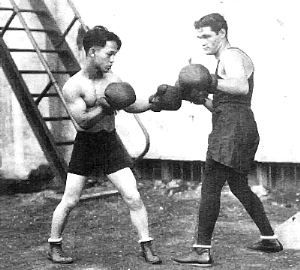
Dick Chang posing with California boxer Paul de Hate around 1927.
Note 16-ounce training gloves. Courtesy the Paul Lou collection.
In addition, there were fight clubs for Koreans such as Walter Cho, and for Japanese such as Patsy Fukuda, Henry Kudo, and the brothers Spud and "K.O." Kuratsu. Cho went on to become a well-known referee, while Fukuda became coach of Hawaii’s 1949 AAU boxing team.
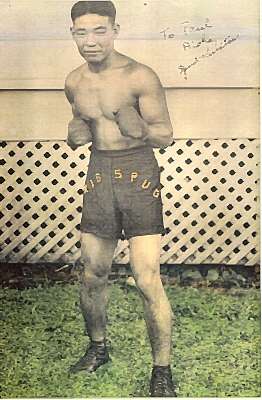
Spud Kuratsu. The inscription reads, "To Paul Aloha, Spud Kuratsu."
Courtesy the Paul Lou collection.
Training Methods and Contests
Regardless of ethnicity, bootleg boxers used similar methods during training. As a rule, they began hard training about three weeks before a scheduled match. A typical training day included sparring 6-10 rounds before work in the morning. In the afternoon, after work, the boxers ran about ten miles uphill, and then walked back.
The gloves most boxers wore during both sparring and fighting weighed just 6 ounces. In addition, they did not wear headgear, as it had only just been introduced. Thus, during sparring, boxers generally tried to avoid hurting one another.
During contests, things could get heated. For example, Nelson Tavares recalled Jack McFadden forcing him into clinches and then spitting in his face (Advertiser, April 9, 1949).
As a rule, however, the goal was simply to give the crowd a lot of action. For example, here is how William Peet (Advertiser, January 6, 1941) recalled a Kewalo Athletic Club fight of the late 1920s:
Flint, a good boxer, one-time Pacific Coast collegiate champion [at
Stanford], was to have refereed the main scrap. He put on the gloves with
Bolo. The first round was fast and interesting. In the second round, Mr.
Flint forgot to pull his punches and tapped Bolo a stiff jab on the nose.
Bolo uncorked a right from the ring floor, the blow landed flush on the
jaw, and the lights went out for J. Donovan. He says he was only dazed,
but I saw the fight and helped Brother Flint come back to earth.
The following lists are incomplete, and people with additional information
are invited to contact the author at jsvinth@ejmas.com.
Joe Azevedo
1896?-February 19, 1934
Weight: Lightweight
Manager: Jimmy Rohan
|
12-Mar-13
|
Red Robinson | Oakland, CA | W6 |
|
6-Apr-13
|
Harry Baker | Oakland, CA | Exh4 |
|
16-Apr-13
|
Frankie Burns | Oakland, CA | L10 |
|
13-Aug-13
|
Tommy McFarland | Oakland, CA | W10 |
|
1-Sep-13
|
Adolph "Ad" Wolgast | Oakland, CA | W10 |
|
14-Oct-13
|
Johnny Dundee (Giuseppe Carrora) | Vernon, CA | L20 |
|
16-Dec-13
|
Owen Moran | Oakland, CA | WF6 |
|
10-Feb-14
|
Grover Hayes | Oakland, CA | D10 |
|
20-Oct-14
|
Johnny Dundee | Oakland, CA | L10 |
|
23-Mar-14
|
Charley White (Charles Anschowitz) | Racine, WI | L10 |
|
7-May-14
|
Joe Bayley | Oakland, CA | D10 |
|
7-Aug-14
|
Charley White | San Francisco | L by KO18 |
|
20-Oct-14
|
Johnny Dundee | Oakland, CA | L15 |
|
24-Nov-14
|
Frankie Burns | Oakland, CA | L15 |
|
18-Dec-14
|
Sally Salvadore (Salvadore Michel) | Sacramento | W20 |
|
22-Mar-15
|
Johnny Dundee | Memphis, TN | L8 |
|
5-Apr-15
|
Frank Russell | W15 | |
|
6-Jul-15
|
Joe Welling | Memphis, TN | D |
|
14-Jul-15
|
Ralph Grunan | New York, NY | L |
|
28-Jul-15
|
Saylor Shades | Boston | L |
|
9-Oct-15
|
Rob Peau | D | |
|
18-Oct-15
|
Richie Mitchell | Milwaukee, WI | NoDec10 |
|
19-Nov-15
|
Benny Leonard | New York, NY | NoDec10 |
|
1-Jan-16
|
Johnny Dundee | Philadelphia, PA | NoDec6 |
|
11-Mar-16
|
Johnny O'Leary | Philadelphia, PA | NoDec6 |
|
14-Apr-16
|
Willie Hoppe | San Francisco | L4 |
|
18-Aug-16
|
Benny Leonard | New York, NY | NoDec10 |
|
18-May-17
|
Al Young | Sacramento | ? |
|
30-Jan-19
|
Manuel "Battling" Viera | San Francisco | D4 |
|
22-Feb-19
|
Oakland Jimmy Duffy (Hyman Gold) | Oakland, CA | L4 |
|
9-Apr-19
|
Joe Miller | Oakland, CA | D4 |
|
9-Jan-20
|
Joe Miller | San Francisco | D4 |
|
6-Feb-20
|
Alex Trambitas | San Francisco | D4 |
|
8-Oct-20
|
Joe McIvor | Fresno | W4 |
|
5-Dec-20
|
Frankie Farren | San Francisco | W4 |
|
12-Dec-20
|
Joe Miller | San Francisco | D4 |
|
23-Jan-20
|
Fred Murphy | San Francisco | D4 |
|
13-Feb-20
|
Billy Wright | Seattle | L4 |
|
17-Mar-20
|
Frankie Burns | Oakland, CA | D4 |
|
22-Apr-20
|
Johnny McCarthy | San Francisco | L4 |
|
3-Sep-20
|
Johnny McCarthy | San Francisco | L4 |
|
27-Oct-20
|
Willie Robinson | Oakland, CA | D4 |
|
17-Nov-20
|
Young France | Oakland, CA | L4 |
|
30-Aug-22
|
Johnny Cline | Oakland, CA | D4 |
|
6-Sep-22
|
Johnny Cline | Oakland, CA | L4 |
|
26-Sep-22
|
Bud Soules | Oakland, CA | D4 |
|
11-Oct-22
|
Eddie Landon | Oakland, CA | W4 |
|
25-Oct-22
|
George Lavigne | Oakland, CA | W4 |
|
20-Dec-22
|
Eddie Mahoney | Oakland, CA | D4 |
Geronimo Carpenterio
September 22, 1892-May 11, 1964
Weight: Lightweight
Manager: F. Ocampo
|
21-Aug-19
|
Kid Ave | Moili’ili Park | KO3 |
|
1919
|
Young Pangelina | Honolulu | KO3 |
|
1919
|
Kid Carbalho | Honolulu | KO1 |
|
1919
|
Battling Campton, USS New York | Honolulu | D6 |
|
1919
|
Macdonal | Honolulu | D6 |
|
1919
|
Young Poloc | Honolulu | W4 |
|
1920
|
Big Bebing | Honolulu | L8 |
|
1920
|
Francisco Valdes | Honolulu | WF2 |
|
1920
|
Iron Jaw Fontana | Honolulu | D4 |
|
1920
|
Iron Jaw Fontana | Honolulu | W6 |
|
1920
|
Iron Jaw Fontana | Honolulu | LF2 |
|
1920
|
Iron Jaw Fontana | Honolulu | W6 |
|
1921
|
Vense More | Honolulu | TKO3 |
|
17-Mar-21
|
Young Joe River (Burpee) | HNG Armory | D6 |
|
7-May-21
|
Iron Jaw Fontana | HNG Armory | ? |
|
1922
|
Sailor Moffett | Honolulu | KO2 |
|
1922
|
Red Boyce | Honolulu | KO3 |
|
1922
|
Alky Dawson | Honolulu | TKO7 |
|
1922
|
Alky Dawson | Honolulu | W6 |
|
16-May-22
|
Kid Korea | Pan Pacific AC | ? |
|
8-Jul-22
|
Pedro "Kid" Ray | Kewalo AC | L6 |
|
1922
|
Alky Dawson | KO5 | |
|
1923
|
Alky Dawson | LF3 | |
|
1923
|
Sgt. Sammy Baker | Schofield Barracks | LF3 |
|
25-Jan-23
|
Sgt. Sammy Baker | Schofield Barracks | L6 |
|
1924
|
Patsy Fernandez | D6 | |
|
1924
|
Patsy Fernandez | D6 | |
|
1925
|
Patsy Fernandez | KO1 | |
|
1925
|
Sharkey Wright | Exh4 | |
|
1925
|
Battling Pontes | KO1 | |
|
1925
|
Valinten Galit | TKO4 | |
|
1925
|
Kid Burpee | D6 | |
|
8-Apr-25
|
Patsy Fernandez | Maui Fairgrounds | D6 |
|
10-Nov-25
|
Patsy Fernandez | Honolulu Native Sons | ? |
|
6-Dec-25
|
Young Denny | Kewalo AC | KO1 |
|
30-Dec-25
|
Johnny Priston | Kewalo AC | W6 |
|
1-Apr-26
|
Frankie Marshall | Stockton, CA | W4 |
|
15-Apr-26
|
Billy Reyes (a.k.a. Billy Raye?) | Stockton, CA | D6 |
|
29-Apr-26
|
Red Robinson | Stockton, CA | W6 |
|
5-Oct-26
|
Young Corbett III (Raffaele Capabianca Giordano) | Fresno, CA | KO by 6 |
|
22-Oct-26
|
King Tut (Henry Tuttle) | Sacramento, CA | L by TKO4 |
Dick Chang
May 7, 1903-September 25, 1993
Weight: Flyweight to bantamweight
Managers: Paul de Hate, Dick Clark
|
26-Feb-27
|
Kid Topaz | Honolulu | L4 |
|
Mar-27
|
Young Borong | Honolulu | D |
|
18-Mar-27
|
Kid Villa | Honolulu | W4 |
|
11-Apr-27
|
Fred Hayashi | Honolulu | L3 |
|
12-Aug-27
|
Johnny Lopez | Compton, CA | KO3 |
|
Aug-27
|
ND | California | W |
|
Aug-27
|
ND | California | W |
|
Sep-27
|
ND | California | W |
|
Sep-27
|
ND | California | L |
|
19-Sep-27
|
Kid Martin | Los Angeles | KO2 |
|
4-Oct-27
|
Madison Grover | San Diego | W6 |
|
16-Oct-27
|
George Prieto | Los Angeles | W6 |
|
21-Oct-27
|
Yama Soko | San Diego | W6 |
|
22-Oct-27
|
Yama Soko | Los Angeles | W4 |
|
15-Nov-27
|
Pegino Palimini | Los Angeles | W4 |
|
30-Nov-27
|
Benny Flores | Los Angeles | L4 |
|
4-Dec-27
|
Presecto Mendoza | Los Angeles | L4 |
|
6-Dec-27
|
Louie Contreras | Los Angeles | Stopped 2 |
|
20-Dec-27
|
Young Pancho Villa (Lou B. Compasanos) | Los Angeles | W4 |
|
16-Feb-28
|
Robert Rodriguez | Ocean Park, CA | L4 |
|
16-Feb-28
|
Dick Lucero | Pasadena | L4 |
|
26-Feb-28
|
Bobby Mars | Los Angeles | D6 |
|
1928
|
Joe Garcia | California | D4 |
|
11-Jul-28
|
Joe Garcia | El Rio, CA | KO2 |
|
1929
|
Al Sampson | Ocean Park, CA | KO2 |
|
1929
|
Johnny Ryan | Wilmington, CA | W6 |
|
1929
|
Peewee Nolan | Los Angeles | W4 |
|
1929
|
Freddie Imperial | Calexico | D10 |
|
1-May-29
|
Kewpie Hernandez | Los Angeles | D |
|
8-May-29
|
Peppy Pat O'Shea | Wilmington, CA | W6 |
|
10-May-29
|
Manolo | El Centro, CA | W6 |
|
14-May-29
|
Yama Soko | Pasadena | W4 |
Patsy Fukuda
December 31, 1904-March 26, 1991
Weight: Flyweight to lightweight
|
Oct-25
|
ND | Maui | ||
|
6-Dec-25
|
Frank Villa | Honolulu | W4 | |
|
30-Dec-25
|
Don Cabelleiro | Honolulu | D3 | |
|
5-Feb-26
|
Kid Josephs | Honolulu | W4 | |
|
Apr-26
|
Johnny McCoy | Honolulu | KO2 | |
|
31-Jul-26
|
Don Cabelleiro | Honolulu | Sched; DNF | |
|
4-Sep-26
|
Kid Olds | Honolulu | D6 | |
|
29-Sep-26
|
Don Cabelleiro | Honolulu | D4 | |
|
22-Dec-26
|
Jack Griff | Honolulu | KO5 | |
|
26-Feb-27
|
Kid Samar | Honolulu | W6 | |
|
18-Mar-27
|
Kid Samar | Honolulu | Sched; DNF | |
|
Apr-27
|
Jimmy Tatto | Honolulu | ? | |
|
Apr 1927
|
Freddie Iloilo | Honolulu | ? | |
|
13-Aug-29
|
Don "Lefty" Freitas | Honolulu | W6 | |
|
21-Dec-29
|
Don "Lefty" Freitas | Honolulu | KO by 3 | |
|
29-Dec-29
|
Don "Lefty" Freitas | Honolulu | KO by 9 | |
|
24-Mar-34
|
Andriano "Kid" Respicio | Honolulu | TKO2 | |
Endnotes
EN1. In 1921, Commander Chester Nimitz was in charge of the submarine base at Pearl Harbor, and Lt. Harley Cope was responsible for most Sub Base smokers. Nimitz was of course commander of the Pacific Fleet during World War II, while Cope’s subsequent accomplishments included publishing a book on submarine warfare, writing the chapter on leadership that appeared in the 1951 edition of the Navy Officers Manual, and retiring as a rear admiral.
EN2. Following his separation from the service, Kilsner
fought professionally under the name Jack Kelsey, and by 1916, he was fighting
10-round main events in New York.